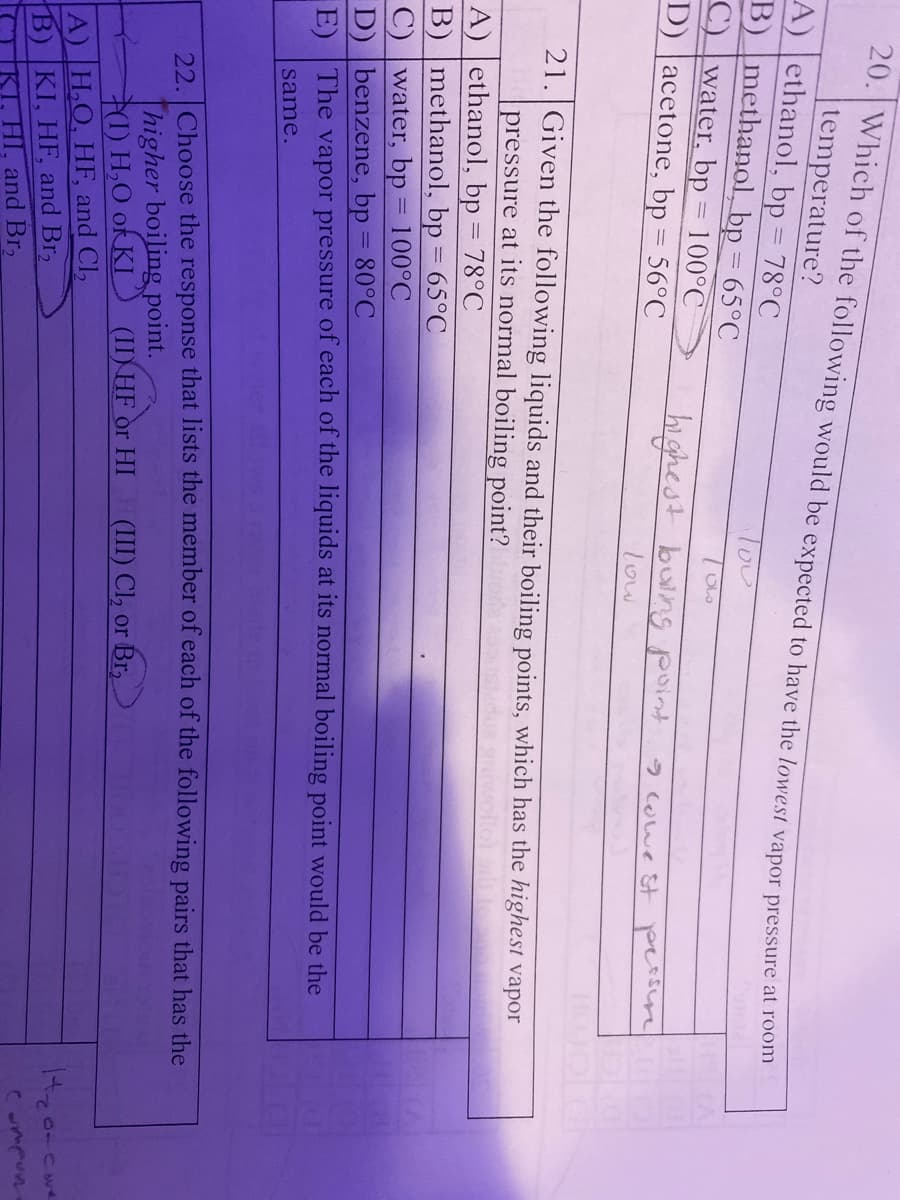Chemistry & Chemical Reactivity
9th Edition
ISBN:9781133949640
Author:John C. Kotz, Paul M. Treichel, John Townsend, David Treichel
Publisher:John C. Kotz, Paul M. Treichel, John Townsend, David Treichel
Chapter11: Intermolecular Forces And Liquids
Section: Chapter Questions
Problem 38GQ: The following data are the equilibrium vapor pressure of limonene, C10H16, at various temperatures....
Related questions
Question
Explain #21 pls

Transcribed Image Text:20. Which of the following would be expected to have the lowest vapor pressure at foomm
|temperature?
A) ethanol, bp = 78°C
B) methanol, bp = 65°C
Tou
%3D
C) water, bp = 100°C
%3D
D) |acetone, bp = 56°C
highest buing point
2wwe st persire
low
21. Given the following liquids and their boiling points, which has the highest vapor
pressure at its normal boiling point?
A) ethanol, bp = 78°C
B) methanol, bp = 65°C
C) |water, bp
D) benzene, bp = 80°C
E) The vapor pressure of each of the liquids at its normal boiling point would be the
100°C
same.
22 Choose the response that lists the member of each of the following pairs that has the
Thigher boiling point.
71) H,O ok KI
A) H,O, HF, and Cl,
B) KI, HF, and Br,
KT, HI, and Br,
(II) HF or HI
(III) Cl, or Br,
Compun
Expert Solution
This question has been solved!
Explore an expertly crafted, step-by-step solution for a thorough understanding of key concepts.
Step by step
Solved in 2 steps

Knowledge Booster
Learn more about
Need a deep-dive on the concept behind this application? Look no further. Learn more about this topic, chemistry and related others by exploring similar questions and additional content below.Recommended textbooks for you

Chemistry & Chemical Reactivity
Chemistry
ISBN:
9781133949640
Author:
John C. Kotz, Paul M. Treichel, John Townsend, David Treichel
Publisher:
Cengage Learning

Chemistry & Chemical Reactivity
Chemistry
ISBN:
9781337399074
Author:
John C. Kotz, Paul M. Treichel, John Townsend, David Treichel
Publisher:
Cengage Learning

Chemistry: Principles and Reactions
Chemistry
ISBN:
9781305079373
Author:
William L. Masterton, Cecile N. Hurley
Publisher:
Cengage Learning

Chemistry & Chemical Reactivity
Chemistry
ISBN:
9781133949640
Author:
John C. Kotz, Paul M. Treichel, John Townsend, David Treichel
Publisher:
Cengage Learning

Chemistry & Chemical Reactivity
Chemistry
ISBN:
9781337399074
Author:
John C. Kotz, Paul M. Treichel, John Townsend, David Treichel
Publisher:
Cengage Learning

Chemistry: Principles and Reactions
Chemistry
ISBN:
9781305079373
Author:
William L. Masterton, Cecile N. Hurley
Publisher:
Cengage Learning

Chemistry: An Atoms First Approach
Chemistry
ISBN:
9781305079243
Author:
Steven S. Zumdahl, Susan A. Zumdahl
Publisher:
Cengage Learning


Chemistry
Chemistry
ISBN:
9781305957404
Author:
Steven S. Zumdahl, Susan A. Zumdahl, Donald J. DeCoste
Publisher:
Cengage Learning